Trumpeter | 1/32nd Scale Lockheed P-38 L-5-LO
Reviewed by Chris Sherland

A Brief History of the P-38

An Early model Lighting over Southern California in 1941
The P-38 Lightning is arguably the most exotic single-seat fighter to see service with the USAAF in WWII, and is undoubtedly one of the most distinctive aircraft designs of all time. Designed as a purebred interceptor in 1937 by Kelly Johnson for Lockheed, it was destined to become the mount of the highest scoring aces of any US air-service in history by a wide margin.
It was in response to a US Army Air Corps challenge to bring forward an aircraft capable of 360mph at altitude (20,000ft) and a 6 minute climb to get there, that the Lightning found it's design acorn. Suffice it to say there was no propeller-driven aircraft in the world at that time that could even come close to that performance, and given the size and weight of the fighters in the late 30s, it was assumed that a performance outline so defined would require an engine with an output of roughly 1600hp. The 12 cylinder Allison V-1710 series was the highest output engine available to US manufacturers and it was still untested at only 1000hp at that time. Well then…if one could keep the airframe weight reasonably low, why not just use two of them?
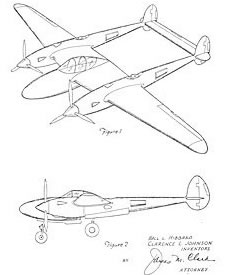
One of Kelly Johnson's original design sketches
The sleek and slender P-38 found it's initial design seed from just that question. Using thin twin-booms to house the pair of Allisons, hold a wide horizontal stabilizer, and end in separate vertical stabilizers, Kelly's initial design concepts for the XP-38 suggested a complete rethinking of conventional fighter design.
Teething problems followed the Lightning all the way into combat however. A dangerous "compressibility" issue was addressed with dive flaps, a destructive tail flutter was fixed with weighted elevators, and poor high-speed roll rate was addressed with power-assisted ailerons. Finally however, it was a simple cockpit heating problem that hurt the Lightning the most. With the majority of air combat in the ETO being carried out in the freezing cold altitudes of 20,000 and 30,000 feet, P-38 pilots simply could not endure the demands of combat without proper heating. This in conjunction with the Allison V-1710 having a similar response to that same thin air, the Lightning was most effectively used in the PTO where combat was often carried out below 20,000 feet, and indeed well below most of the time.
Twin engines also made the Lightning a safer choice for the long over-ocean flights in the PTO. It was more economic than the heavy Thunderbolt, and packed a stiff punch with its single nose-mounted 20mm cannon and four .50 caliber machine guns. Mounted close together in the nose the Lightning's guns needed little harmonization to be effective. Pilots found the P-38 to be a simple plane to "hit with".
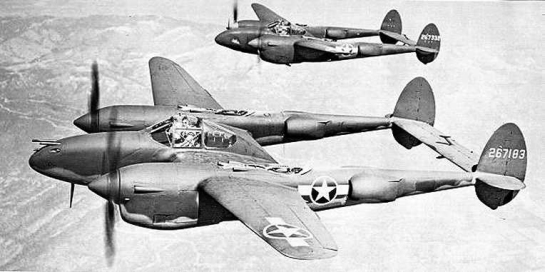
'38s over the hostile mountains of Southern California...again.
The P-38 also found success in ground attack roles in both the ETO and the PTO. It was able to carry two 1,000lb bombs, and 10 rockets in addition to it's strafing abilities. While the liquid-cooled Allison engines were more vulnerable to ground fire than a tough radial, simply being able to lug all that ordinance to target gave the Lightning an advantage in train and bridge-busting, as well as airfield raids.
The P-38 was also fitted with cameras and used as a recon ship with huge success. As well, with a Nordon bombsite (the same one installed in B-17s and B-24s) in it's nose it was used as a pathfinder for formations of fighter-bombers or attack aircraft with inferior bombsights.
All told the Lightning made air combat history all over the world during WWII, with distinctive combat records in the MTO, ETO, PTO, and the Aleutians. In the PTO however the P-38 was to find it's real combat "home" flying and fighting against the IJA and IJN.
Richard Bong, Thomas McGuire, Charles MacDonnald, Gerald R. Johnson, Jay T. Robbins, Robert Westbrook, and Tommy Lynch all flew Lightnings to ace-dom filling the top 7 slots of the 10 highest-scoring pilots in that theater.
The Kit
Trumpeter is quickly pulling away from all its competitors in 1/32 and 1/24. And it's doing so quite boldly. With the release of the P-38 Lightning in 1/32 Trumpeter has all but healed the old "large scale wounds" that have gone un-dressed since Revell's timeless push in the late '60s. While certainly a popular aircraft, the Lighting is large, and in 1/32 it's huge. If size is a factor in the purchase of a model kit, this one gives the buyer a lot to think about. Trumpeter has taken a risk here with the size of this kit, but if the Lightning was in need of some attention in 1/32, consider this release a ticker tape parade. In danger of blowing the review this early, let me say up front that this is one fine kit with few problems and a heap of "magic" that flies out of the box when you open it. But then again, with a retail price of $119.95 it should be expected to beguile you.
362 parts on 19 sprues, plus rubber tires, metal aileron and flap shaft, photo-etched control surface hinges engine intake netting and harness buckles, film instrument panel, full engine detail, working flaps, 19'' wingspan, and two decal choices researched by Eagle Editions. Yes, it all fits into one box. A big one.
http://www.trumpeter-china.com/en/menu/plan/1-32/02227.htm
Surface detail is well done and accurate, with recessed panel lines and full rivet detail. Some injector pin marking is evident, but only one "issue" arises here, and that is on the face of the seat back.

Some filler and sanding...not a big deal
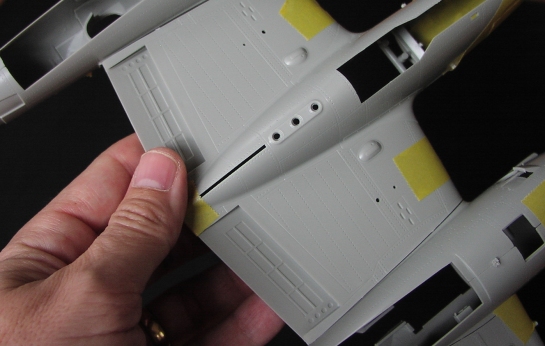
Some nice detail including formation lights and fowler flap bays
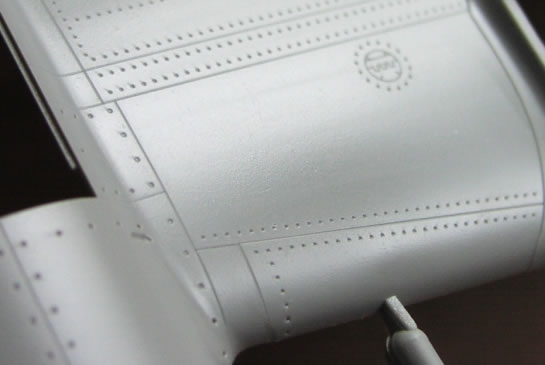
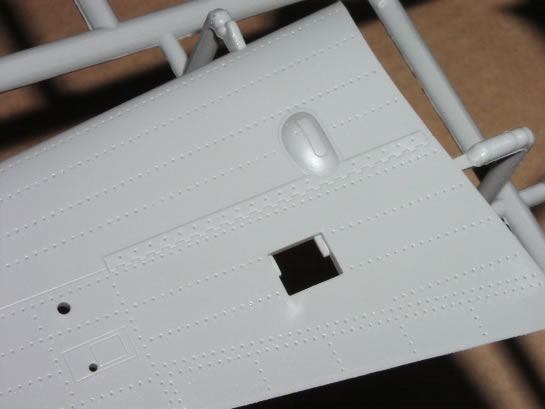
Assembly looks to be classic Trumpeter: Decent fit and a bit of hassle thrown in with the articulating controls and their photo-etched hinge/pin system. I took the liberty of "freeing" the Lockheed from its sprues (I was possessed with a mixture of glee and madness) for a quick test fit of the basic airframe. I was expecting a limp and floppy mess without the innards assembled and in place, but what I got was a sound fit, with evident strength. Clearly well engineered this looks like it will build up as well as any Lightning kit can given the bizarre layout and construction of the real airframe. Trumpeter recommends a 60g nose weight in the instructions, but that should be nothing new to tricycle builders. I found no "bad fit" spots in my quick tape-up of the beast at all, and the overall impression I got seeing it in shape was that this would be an impressive build. Granted, once the gunbay, wheelweels, and cockpit are all stuffed in place, any number of things could crop up and I would caution that it ain't over till she's sitting on all three.
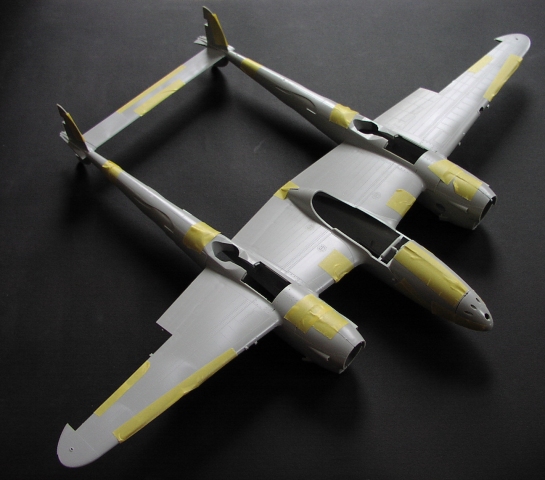
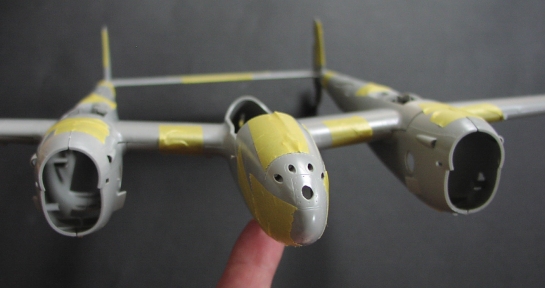
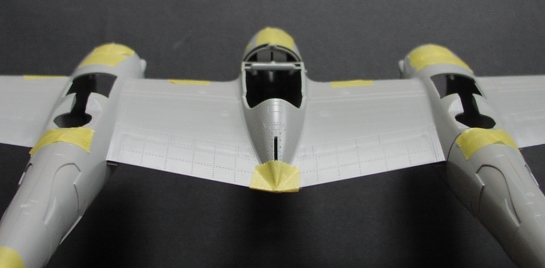
The cockpit initially looks to be a bit plain. Some aftermarket stuff will no doubt be released soon, as that market rushes to respond to Trumpeter's lead. However, out of the box Trumpeter's office effort should look very nice. The Throttle quadrant alone is 10 pieces, using 6 photo-etched handles for prop advance, fuel mixture, and manifold pressure doubled for two engines. Quite nice.The panel is a clear part as per the usual Trumpeter treatment, and a high-quality film is supplied for the instruments. All the basic suspects are included, but a purist may indeed look to Waldron's amazing set for the P-38 in this scale to bring real quality to the office.
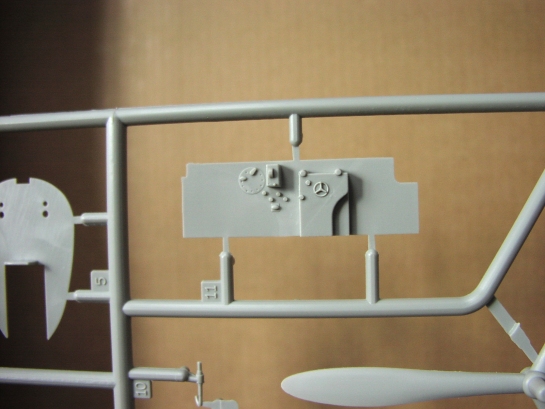
I think the word "plain" is accurate here.


This picture doesn't do the film justice. It's very nice.
The gearbays are accurate and fairly well detailed as are the struts and wheels, and all of the gear struts feature 2-part scissor links. The wheels are accurately done, and the tires look to be the right size (the '38s main gear had some beefy rubber!).
The engines are no less than 30 pieces each including all turbo ducting (which is supplied in more detail than any Lightning kit made to date). They are done well, and include some rubber pieces for harness detail etc.
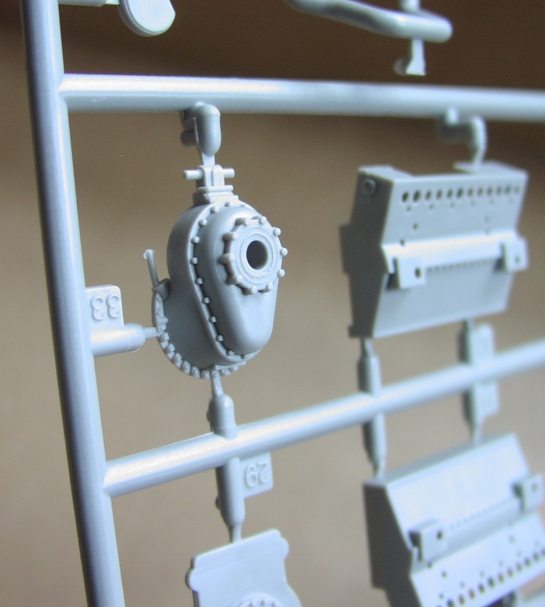
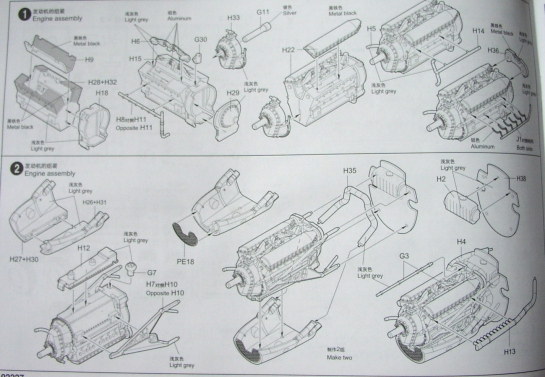
The Gunbays are also a nice focal point. The two geometric clamshell service doors on either side of the center fuselage are perfectly rendered and designed to be modeled open or closed. The bays, guns, ammo feeds and ammo boxes go together in about 20 pieces and will look good. The barrels of the .50s are solid however.
Loadout for the big Lockheed includes two of the distinctive "teardrop" 300 gal droptanks, two 500lb bombs, and rocket racks for each wing sporting five rockets each.
The clear sprue is the expected high-quality trumpeter offering. They strike a very nice balance with the textured portion of their clear sprues, and the Lightning is no exception. Clear parts are included for the canopy, nav and formation lights, instrument panel (to be painted), and the nose gear reflector panels (described below).
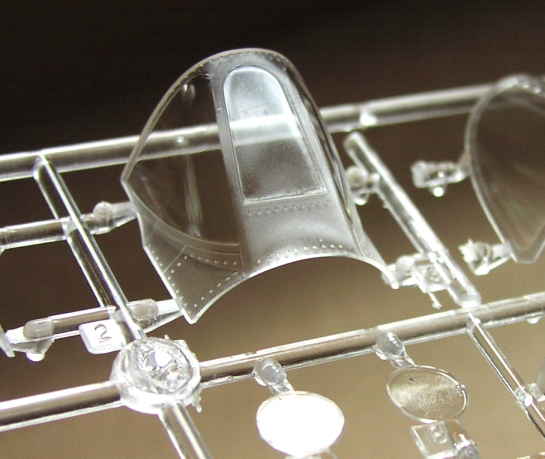
Trumpeter has also done the roll-up side windows well, however to mount them in any rolled down fashion will take a bit of engineering as the only mounting option that is suggested in the instructions is for them closed.
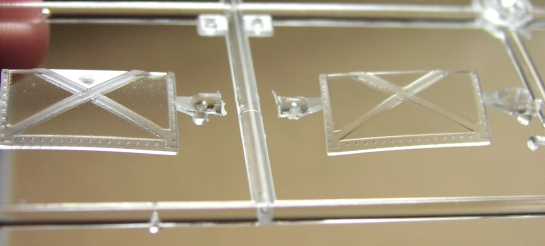
The P-38 has two distinctive round panels on the inboard of the engine nacelles, visible from the cockpit. As I recall these were highly polished and served as "mirrors" to visually check the status of nose gear while either on approach or after rotation. These are modeled as clear parts, and I cannot imagine why. Perhaps there was a snafu in translating these panel's purpose and they were interpreted as inspection panels. Hmmm.
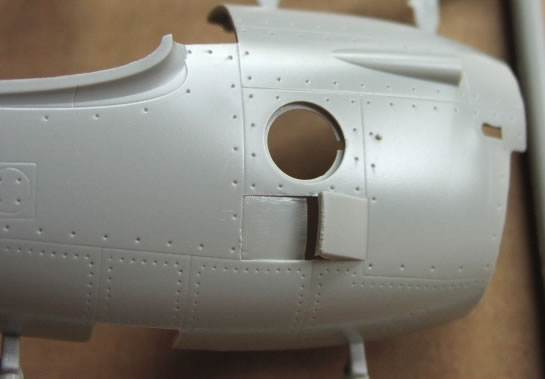
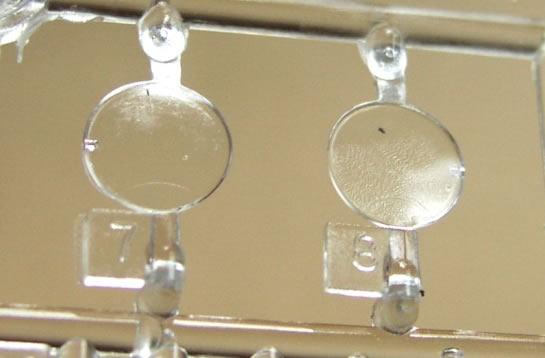
Some nice touches can be found throughout the kit. Gun alignment tubes are a welcomed feature for the nose section. Even if the kit parts are not used, these tubes will make mounting barrels very easy.
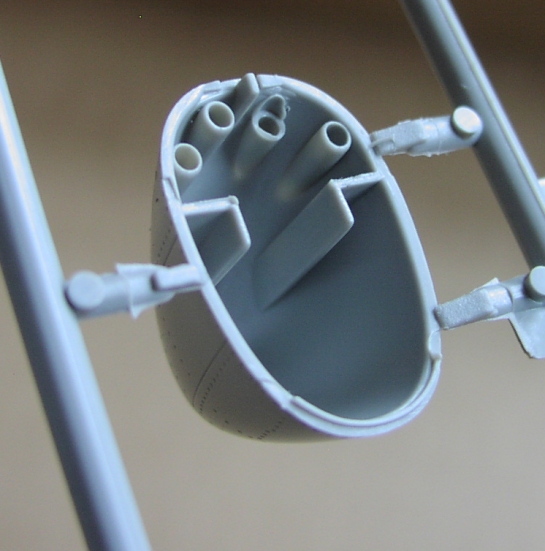
Photo-etch and other extras
Trumpeter is no doubt committed to multimedia throughout their entire line. This kit comes with the standard fare for 1/32 and 1/24 aircraft kits from them.
Two frets of photo-etched parts are included. One focusses on the hinge/pin control surface system, while the other contains some new goodies. The second fret contains harness buckles, as well as radiator grills and very cleverly modeled dive flaps.
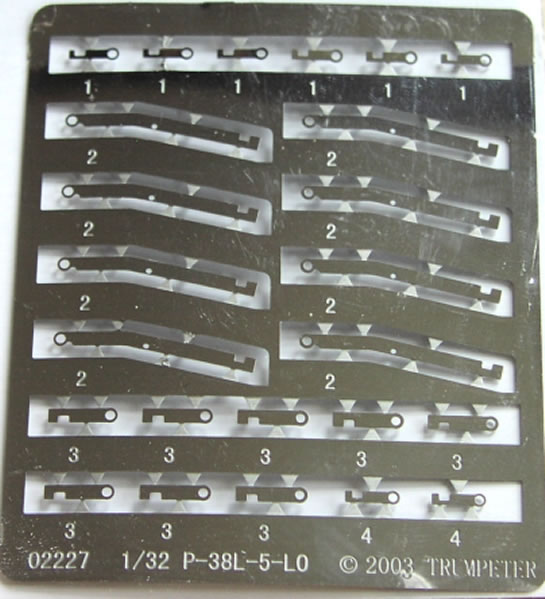
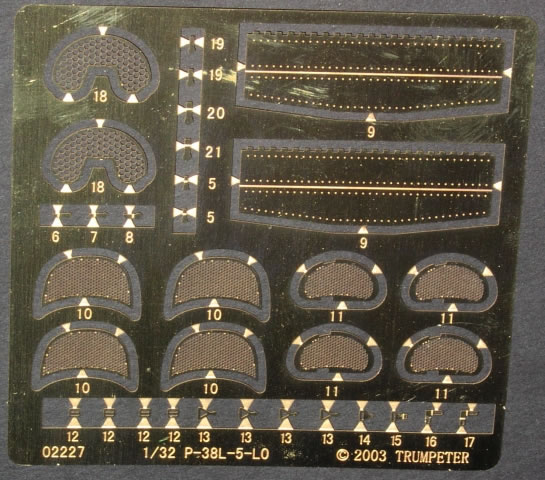
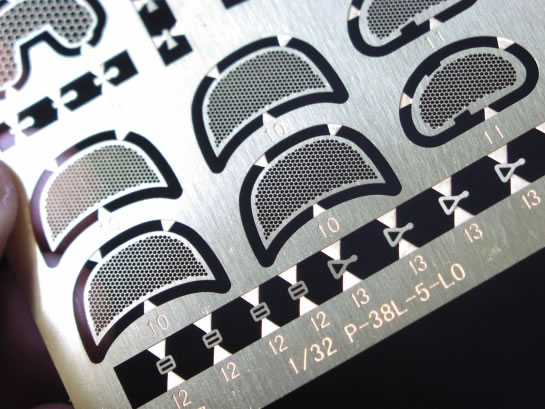
A single sprue of rubber hoses and lines is included as well as a bag of pins for the hinged control surfaces. These items round out the multi-media.
Decals
Researched and designed by Eagle Editions, the Lightning's decal sheet is printed by Cartograf in Italy. These look to be high quality decals, finely printed, and in register. They include minimal stenciling and while some of the smaller stencils are impressively rendered, there are some that are left strangely simplistic.
However overall the sheet is very nice, and offers two interesting choices:
- "Black 20" flown by Maj. Donald Campbell, 36th F.S.,8th F.G. 1944
- "Itsy Bitsy II" flown by Maj. George Lavin Jr., 54th F.S., 343rd FG 1945
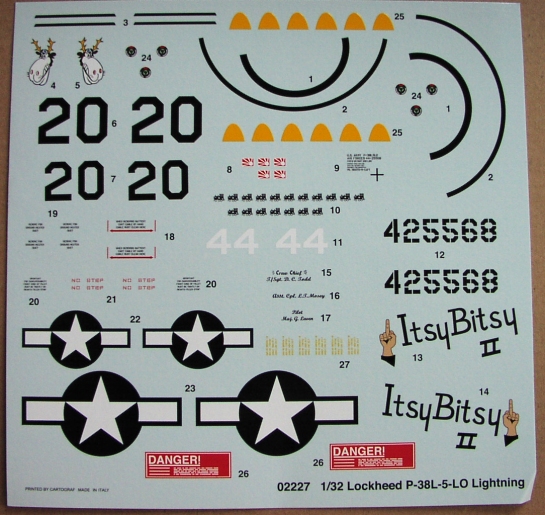
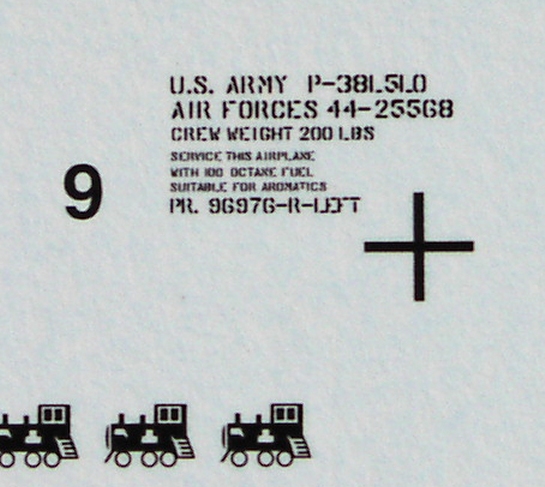
Incredible detail on some of the smallest stenciling...
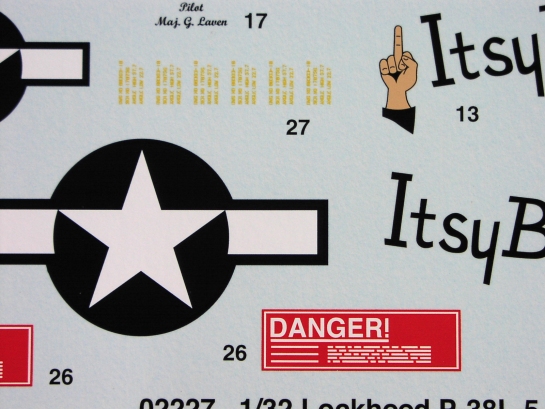
...shares the same sheet with this "Morse code"Danger placard for the dive flaps. Huh?
Shape
Has there ever been a perfectly shaped kit? Is the recent trend in measuring the kit against plans (which I am about to do) a fad of the rivet counters? Who knows, I would challenge anyone to find a way to really check the accuracy of a single set of plans, over an entire airframe. In fact, during the pain and time that would consume, some folks would simply be building models. None the less, the cries are heard far and wide that accuracy is not only expected, but shall be scrutinized. And perhaps to a degree that would rival the engineers of the kits themselves. I see no reason why I shouldn't dip a toe in and see what's what.
My standard disclaimer stands though: The following shape analysis is offered only as a deeper view than one would get by simply opening the box. It is not a hunt for problems, nor a claim that I know the shape of the Lockheed better than you do. I offer two areas that don't "line up" in my view, and to be honest with you, they don't bother me in the least. If you are a Lightning man (or woman) however, brace yourself. These may seem small to me, but hey, you're the reader here.
The following comparisons are done with scaled up scans of the decal instruction sheet provided by Eagle Editions.
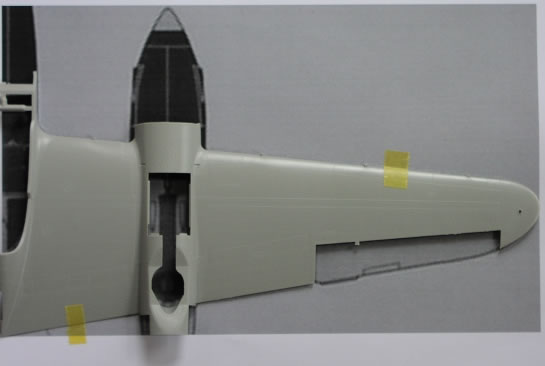
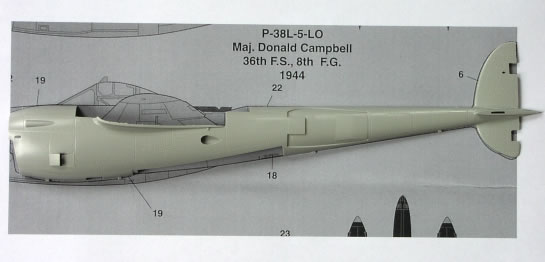
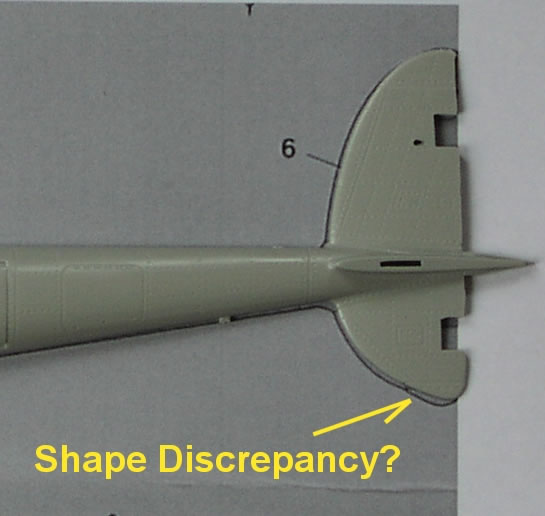
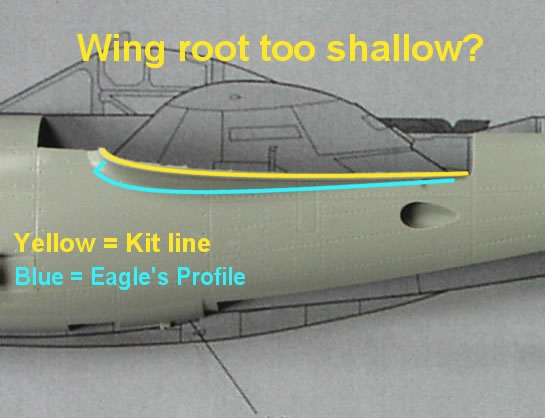
Conclusion
While not the brisk 134 pieces of the MiG-3 (Trumpeter's last 1/32 release), the big Lightning does scream "Build me now!" as the box opens. Not for the simple appeal of the MiG however, no, this kit speaks to a deeper modeling sense and there is an immediate air of challenge on seeing the sprues. Every time I've ever made a P-38 kit I've always wondered how crooked it would turn out. Trumpeter's P-38 not only raises that fear, but it demands that you find out with a 19" wingspan. When I build this model, I will assemble a jig first, and I would suggest that you do as well. It's engineered quite nicely, but it's a huge Lightning and the laws of physics say that there will be line up challenges. When the booms go on, and the center wing assembly is joined there are no spars, and nothing but regular assembly pins to guide you.
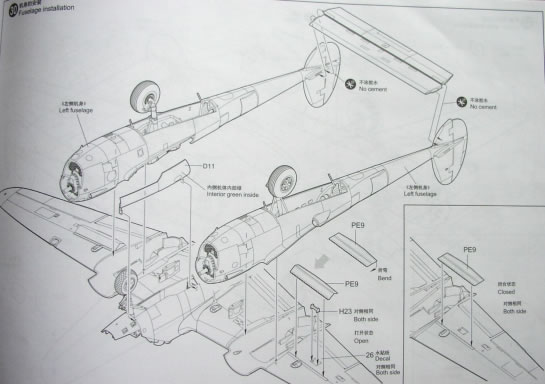
Look at "Step 30" here from the instructions....eeek!
I would challenge William Wallace to not run screaming. But then again, are we not men? I would posit that buying and assembling this kit could be a life-changing event. Consider the money you'll save in psychotherapy: You will truly know what you are made of when "Step 30" comes along, and all for about $120.00. Of course a natural metal finish is suggested on top of all that (all L model Lightnings were shipped into combat thusly). Yes my friends, this could be the kit that bends you to your limit, or breaks you, and it'll demand your whole bench while it does so.
Highly recommended for both hobby and spiritual fulfillment.
Thanks to Stevens International for the review sample.
© Chris Sherland 2004
This review was published on Saturday, July 02 2011; Last modified on Wednesday, May 18 2016
